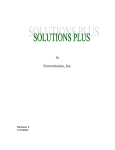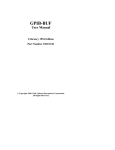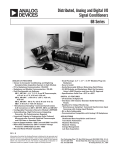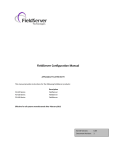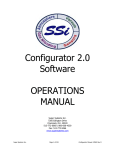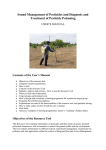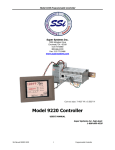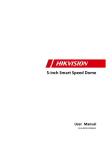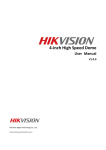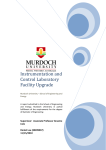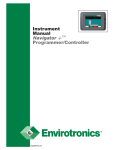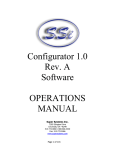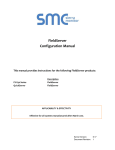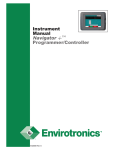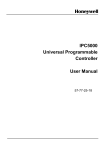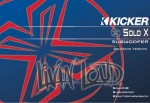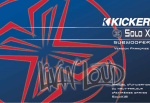Download Systems Plus™ Programmer/Controller
Transcript
Systems Plus™ Instrument Manual Systems Plus™ Programmer/Controller Revision 6 9/12/97 START 7 8 9 STOP 4 5 6 OFF 1 2 3 HELP – 0 . envirotronics ALARM ALARM ACK ALARM RESET ENTER DEL 2 Table of Contents Menu Map .......................................................................................................................................................................... 4 General Information ........................................................................................................................................................... 5 Channel Set-up Notes ......................................................................................................................................................... 6 Starting the Systems Plus ................................................................................................................................................... 7 Starting the System .............................................................................................................................................. 7 Start Manual Mode ................................................................................................................................ 7 Start, via Program .................................................................................................................................. 7 Selecting a Program to Run ................................................................................................................... 7 Stopping the System ............................................................................................................................................. 8 Manual Output Control ....................................................................................................................................................... 9 Manual Event Control ............................................................................................................................ 9 Manual Setpoints ................................................................................................................................... 9 Programming the Systems Plus Controller ....................................................................................................................... 10 Loading a Program ............................................................................................................................................. 10 Saving a Program ............................................................................................................................................... 10 Editing a Program .............................................................................................................................................. 10 The Editor Screen: ............................................................................................................................... 10 Editing Options .................................................................................................................................... 11 Inserting a New Step ............................................................................................................................ 11 Clearing a Program .............................................................................................................................. 11 Selecting a Setpoint in a Program Step ................................................................................................ 11 Guaranteed Soaking ............................................................................................................................. 12 Soak Window Adjustment ................................................................................................................... 12 Step Time Duration .............................................................................................................................. 12 Programming Events ........................................................................................................................... 12 Auxiliary Outputs ................................................................................................................................ 12 Program Flow / Branching ................................................................................................................... 13 Exiting Editor Mode ............................................................................................................................ 13 Programming from Remote Terminal ................................................................................................................ 13 System Logging ................................................................................................................................................................ 14 What Can You Log ............................................................................................................................................. 14 Logging Data ....................................................................................................................................... 14 Logging Alarms ................................................................................................................................... 15 When to Log Data ................................................................................................................................ 15 Where to Log Data ............................................................................................................................... 15 Format of Logged Data ........................................................................................................................ 15 Log Clearing, Printing, and Storage .................................................................................................... 16 Configuring Analog Channels .......................................................................................................................................... 16 Entering Channel Configuration ........................................................................................................................ 16 Sensor Type .......................................................................................................................................... 16 Range Setting & Data Scaling ............................................................................................................. 17 Range Setting ....................................................................................................................... 17 Scaling .................................................................................................................................. 17 Addressing Channels ........................................................................................................................... 17 Displaying Units .................................................................................................................................. 17 Channel Definitions Summary ............................................................................................................ 17 Fuzzy Logic Control .......................................................................................................................................... 19 Fuzzy Configuration ............................................................................................................................ 19 Maintenance ..................................................................................................................................................................... 21 Maintenance List Setup ...................................................................................................................................... 21 3 Table of Contents continued Maintenance Information ................................................................................................................................... 21 System Alarms .................................................................................................................................................................. 21 Alarm Configuration .......................................................................................................................................... 21 Audible Alarm ..................................................................................................................................... 21 Selection of Alarms .............................................................................................................................. 21 In the Event of an Alarm .................................................................................................................................... 21 Alarm Occurs ....................................................................................................................................... 21 Alarm Reset ......................................................................................................................................... 22 Alarm Display Mode ........................................................................................................................... 22 Remote Communications ................................................................................................................................................. 23 What is it? .......................................................................................................................................................... 23 Communications Setup ...................................................................................................................................... 23 Setting Emulation / Command mode ................................................................................................... 23 End of Serial Input Command Delimiter ............................................................................................. 23 Serial Port Setting ................................................................................................................................ 24 Handshaking ........................................................................................................................................ 24 Remote Command Set ....................................................................................................................................... 25 Program & System Control ................................................................................................................. 26 Manual Control .................................................................................................................................... 26 Program Menu Commands .................................................................................................................. 27 Program setup ...................................................................................................................................... 27 Alarm Control ...................................................................................................................................... 28 Miscellaneous Commands ................................................................................................................... 28 Editing Commands .............................................................................................................................. 28 Edit Program ........................................................................................................................................ 29 Edit Channel Configuration ................................................................................................................. 30 Edit Alarm Configuration .................................................................................................................... 31 Edit Fuzzy Configuration .................................................................................................................... 31 General Configurations .................................................................................................................................................... 32 <3> Passwords ..................................................................................................................................... 32 <4> System Setup ................................................................................................................................ 32 <5> System Software ........................................................................................................................... 32 System Software Upgrade ................................................................................................................... 33 Diagnostics ....................................................................................................................................................................... 34 <1> PLC Data ...................................................................................................................................... 34 <2> PLC Status .................................................................................................................................... 34 <3> Controller Status ........................................................................................................................... 34 <4> Display Test .................................................................................................................................. 34 <5> Keypad Test .................................................................................................................................. 34 <7> Printer Test ................................................................................................................................... 34 Quick Draw ...................................................................................................................................................................... 35 Calibration\Verification and Preventative Maintenance Procedures ................................................................................ 37 Programming Worksheet .................................................................................................................................................. 39 Logging Translator for DOS. Version 1.0 ....................................................................................................................... 40 Remote Editor/Logging Translator for Windows. Version 1.0 ........................................................................................ 41 IEEE-488 converter set-up ............................................................................................................................................... 46 Troubleshooting Guide ..................................................................................................................................................... 48 Technical Specifications ................................................................................................................................................... 49 Temperature Conversion Chart ......................................................................................................................................... 51 Hexadecimal Conversion Chart ........................................................................................................................................ 56 4 Menu Map MANUAL CONTROL pages PROGRAM MENU pages MAIN MENU page These screens represent the screen displays of the Systems Plus Controller that are accessible through use of the ARROW keys on the keypad. At initialization, the Systems Plus will always come up to the upper most PROGRAM MENU page. The upper right corner of every display indicates directions you may go using the ARROW keys. 5 General information The following explains the different symbols used on the Systems Plus. <> Menu selections that lead to another screen. () Menu selection that will allow you to change the contents of the corresponding [ ] field. [] Indicates modifiable data. When editing that data, it is displayed in reverse video. Abbreviations used. The following explains the various abbreviations used in the Systems Plus. Ch. Set Pt. or SP P.V. Dev. STOP/RUN HOLD Timed Start Timed Stop Channel Set Point Process Variable Deviation Program run state Program is holding Waiting to start at start time. (Program Setup) Program stopped at selected stop time. (Program Setup) Alarms. The following are the alarm abbreviations used in the Systems Plus. LOPS LHTS LHLP HOPS HHTS HHLP WDOG TROP TRHT TRHL COL1 COL2 COL3 POFF TSEN SP01 - SP08 Low Stage Oil Pressure Switch Low Stage Thermal Head Switch Low Stage Hi/Lo Pressure Switch High Stage Oil Pressure Switch High Stage Thermal Head Switch High Stage Hi/Lo Pressure Switch Communications Watch Dog Enviromiser Oil Pressure Switch Enviromiser Thermal Head Switch Enviromiser Hi/Lo Pressure Switch Circulator Motor Overload Station 1 Circulator Motor Overload Station 2 Circulator Motor Overload Station 3 Power Off Temperature Sentry Spare Alarms - Use varies by application Note: Spare alarm one (SP01) will typically be used for the chamber high heat limit (HLS-1) and spare alarm two (SP02) will typically be used for the steam generator thermostat (TAS-1). 6 Module Hex Code Plus Addr. Description 6B11 6B11 6B11 6B11 6B11 6B11 6B11 6B11 6B11 6B11 6B11 6B11 6B11 6B11 0 1 2 3 4 5 6 0E 0F 10 11 12 13 14 0 1 2 3 4 5 6 14 15 16 17 18 19 20 ±15 mV ±50 mV ±100 mV ±500 mV ±1 V ±5 V ±20 mA J Thermocouple 0 to 760˚ C K Thermocouple 0 to 1000˚ C T Thermocouple -100 to 400˚ C E Thermocouple 0 to 1000˚ C R Thermocouple 500 to 1750˚ C S Thermocouple 500 to 1750˚ C B Thermocouple 500 to 1800˚ C 6B12 6B12 6B12 6B12 6B12 6B12 6B12 7 8 9 0A 0B 0C 0D 7 8 9 10 11 12 13 ±50 V ±10 V ±5 V ±1 V ±500 mV ±150 mV ±20 mA 6B13 6B13 6B13 6B13 6B13 6B13 6B13 6B13 6B13 6B13 6B13 6B13 20 21 22 23 24 25 26 27 28 29 2A 2B 32 33 34 35 36 37 38 39 40 41 42 43 Pt, -100 to 100˚ C, .00385 Pt, 0 to 100˚ C, .00385 Pt, 0 to 200˚ C, .00385 Pt, 0 to 600˚ C, .00385 Pt, -100 to 100˚ C, .003916 Pt, 0 to 100˚ C, .003916 Pt, 0 to 200˚ C, .003916 Pt, 0 to 600˚ C, .003916 Ni, -80 to 100˚ C Ni, 0 to 100˚ C Cu, 0 to 120˚ C, (10Ω @ 25˚ C) Cu, 0 to 120˚ C, (10Ω @ 0˚ C) Channel setup notes. The above chart shows the different analog device types used by the Systems Plus. The Analog Devices modules used have a hex code for there initial setup that does not coincide with the codes used in the Systems Plus. For example, if you use a type “T” thermocouple, the hex code on the Analog Devices module 6B11 would be 10. You would select number 16 in the Systems Plus analog device type selection page. 7 Starting the Systems Plus The Systems Plus controller has 2 ways to start control. One method of starting control is by using manual controls (see: Manual Output Control page 9). The other method is by utilizing the Program Setup Mode and a program. (See: Programming the Systems Plus Controller page 10). Starting the System Press the START button on the keypad. A window appears with three possible options. If any of these options are not present, it indicates that option is already in effect. Start Manual Mode (1) Start System will start the system. It will now begin to achieve any manual setpoints that have been entered provided all system safeties are satisfied. (see: Manual Output Control page 9). Start, via Program (2) Start Program # lets you start a selected program. After selection is entered, the system will start the selected program provided that all system safeties are satisfied. Note that you must have a program selected to run. Selecting a Program to Run To choose a program to run you must be on the PROGRAM SETUP screen. Here are 2 ways to reach this screen. <3> Select Program may be selected after pressing the START key on the keypad. This will take you to the PROGRAM SETUP menu (6) Program Setup can be found on any of the 3 pages of the PROGRAM MENU. This will bring you to the PROGRAM SETUP screen. This is the PROGRAM SETUP screen. Its available options are described below. <1> Select Program Number will give you a list of programs in memory. Enter the number of the program you wish to run. (2) Program Starting Step lets you assign a starting step number, other than step 1, to start at in the program. (3) Power Failure toggles between STOP, HOLD, RESUME, and RESET, and tells the controller what to do when it recovers from a power failure. STOP, to stop the program, HOLD, to hold at the particular point of the program where the power failure occurred, RESUME, to continue the program where it stopped when the power failure occurred, and RESET, to restart the program at the Program Starting Step specified in the Program Setup 8 (4) Channel 1 Initial S.P. sets the initial setpoint of channel 1. (5) Channel 2 Initial S.P. sets the initial setpoint of channel 2. (6) Channel 3 Initial S.P. sets the initial setpoint of channel 3. NOTE: The initial setpoints in items 4, 5, and 6 take effect only once the program has been started. It tells the Systems Plus where the setpoint should be at the start of the program. This should typically be set at ambient. (7) Start Time Enabled allows you to enter a date and time at which you would like the program to actually begin controlling, if not immediately. This option will start both the system and the program. You must press the Start button on the Systems Plus and select (2) Start Program # for the option to work correctly. (8) Start Time is the actual date and time the program should begin its cycles. This option will not be displayed unless item 7 is set to YES. NOTE: If (7) Start Time Enabled is set to YES, then a valid time and date must be entered in (8) Start Time. (9) Stop Time Enabled allows you to enter a date and time that you would like the program and the system to stop. (10) Stop Time is the actual date and time you wish a running program to stop at. This option, will not be displayed unless item 9 is set to YES. NOTE: If (9) Stop Time Enabled is set to YES, then a valid time and date must be entered in (10) Stop Time. Stopping the Systems Plus Here are the two ways you can stop the System. Controller Off Key and Stop Key The OFF key on the keypad will automatically stop both the system and a program. The STOP key on the key pad will allow the following selections: (1) Stop Program is available when you press the STOP key on the keypad and will stop the program from running, but leave the system running at the programs last setpoints. (2) Stop System is available when you press the STOP key on the keypad and will stop the system and any program that may be running. (3) Hold Present Values is available when you press the STOP key on the keypad and will hold the program, and stop the step time clock. This option only appears when a program is running. 9 Manual Output Control Go to the MANUAL CONTROL menu using the Menu Map on page 4 of this manual. This is a 2 page screen. Use the UP and DOWN arrow keys to move between these pages. These are the two Pages of the MANUAL CONTROL menu. Manual Event Control An event output is a simple on/off signal that can be used to operate a peripheral device. These are located on the PLC and are triggered from the Systems Plus. The PLC outputs are rated at 2 amps @ 120 VAC. NOTE: Events are typically wired for 120 VAC operation at the factory. (1) (2) (3) (4) (5) (6) (7) (8) Event 1 Event 2 Event 3 Event 4 Selecting an item and pressing the enter key toggles its state between ON and OFF. Event 5 Event 6 Event 7 Event 8 (9) Chamber Lights Lets you turn on the chamber lights from the controller. (10) Circulators Lets you turn on the circulation fans in the chamber. (11) Aux. 1 (12) Aux. 2 (13) Aux. 3 (14) Aux. 4 Items 11 through 14 allow you to turn Auxiliaries 1 through 4, respectively, ON. NOTE: These options only require that the internal safeties to the individual output be set to their proper positions. Manual Setpoints With the system started (see: Starting the System page 7), you may go to the third page of the PROGRAM MENU, (see: Menu Map page 4), screen and select items 7, 8, or 9 and enter values respectively for channels 1, 2, and 3. If all safeties are OK, the system will then try to achieve the manual setpoints you entered. Return to one of the other 2 pages of this screen to view the P.V. values and deviation from the setpoints. 10 Programming the Systems Plus Controller To Load, Save, or Edit a program, you must first be on one of the PROGRAM MENU pages. Refer to the MENU MAP. (See page 4) Loading a Program (1) Load Program. Selecting this item and entering the level 1 password (see: Passwords page 32) when a data disk is in the floppy drive will display a list of programs stored on that disk. Enter the number of the program you wish to load. If you select a program number that has the same number as a program in memory you will be warned and asked if you wish to over write the program in memory or not. Saving a Program (2) Save Program. Selecting this item and entering the level 1 password (see: Passwords page 32) with a data disk in the floppy drive will display a list of programs in the controller’s memory. Select the number of the program you wish to save. If you enter a number and that program already exists on the disk, you will be warned and asked if you wish to over write the file on the disk or not. Editing a Program (3) Edit Program. Selecting this item, followed by the entry of the level 1 password (see: Passwords page 32) will display a list of programs in memory. You may create a new program by entering a program number that is not being displayed, or, enter a program number from the list to edit it. This also saves the program. The Editor Screen: The Editor Screen is made of 2 pages per program step as they are displayed below. You can move in between the 2 pages using the UP and DOWN ARROWS on the keypad. If you are on the second page and there is a step number greater than the one you are on, you may continue to use the arrow keys to move to those as well. To return to the PROGRAM MENU page that you came from, simply press the RIGHT ARROW key. (See Program Editor screens page 11). 11 The two pages of the program editor screen. Editing Options (1) Edit Step selects the step of the current program you wish to edit. There are 999 available steps for each program. (2) Remove This Step will remove the current step from the program and adjust all the step numbers following it. NOTE: If you try to remove a step that is selected as the Next Step from another point later in the program, you will not be allowed to remove it. Inserting a New Step (3) Insert Step Will place an extra step into the program just before the step you are currently on. It will also renumber all of the remaining steps accordingly. NOTE: If you are on a step that is targeted as a next step by a step later or earlier in the program and you INSERT a step here, the inserted step that you add will be the new target of the other steps. Clearing a Program (4) Clear Program will clear the program you are currently editing from memory. (See Editing a Program page 10) Selecting a Setpoint in a Program Step (5) Channel 1 Setpoint (8) Channel 2 Setpoint (11) Channel 3 Setpoint Enter desired setpoint. NOTE: The value you enter must be in the range set by the CHANNEL CONFIGURATION’s “engineering units min. and max.” 12 Guaranteed Soak Guaranteed Soak affects the way a step behaves in terms of its time duration. If G-Soak is ON, the controller will wait until it achieves the setpoint for that step and then will begin the countdown for that step TIME DURATION. If G-Soak is OFF, the controller will try to achieve the set point for that step within the TIME DURATION for that step, thus, the controller begins its countdown as soon as the step is begun. (6) Ch. 1 G-Soak (9) Ch. 2 G-Soak (12) Ch. 3 G-Soak toggles the G-Soak option ON or OFF for each of the respective channels Soak Window Adjustment With Guaranteed Soak on, the TIME DURATION counter does not begin until you have reached your setpoint window. If your Process Variable (P.V.) has any variance outside of the window, your counter will cease until it reaches the setpoint window again. (7) Ch. 1 Window +/(10) Ch. 2 Window +/(13) Ch. 3 Window +/- sets the window range for G-Soak activation as +/- the value you enter, for the respective channels Example: G-Soak for channel 1 is on, setpoint is at 140 degrees F, but the P.V. varies by 2 or 3 degrees off the setpoint. If the WINDOW for the channel is +/- 5, the steps counter will continue. If the P.V. varies more than 5 degrees off setpoint, the step counter will stop until it is back with-in the specified window. Note: Using G-Soak in a "ramp" step will cause the controller to stop the program clock and not allow the program to progress. As a result, the program will never advance to the next step. Use G-Soak only in "soak" steps. Step Time Duration (14) Step Time Duration tells the controller the amount of time this step is to take to achieve the given setpoint (w/ G-Soak OFF), or the amount of time that the step remains at the given setpoint (w/ G-Soak ON). It is in Hours:Minutes:Seconds. The maximum amount of time that can be entered on any one step is 99 hours 59 minutes and 59 seconds. Programming Events Each programming step lets you activate any or all of the 8 event outputs. (15) Event Outputs On lets you activate the event outputs 1 through 8 for this step. Enter the output numbers, in any order, of the events you wish to turn on. Any of the 8 events that were not selected will be set to OFF once you hit ENTER and selected ones set to ON. Auxiliary Outputs Each programming step lets you set any or all of the Auxiliary Outputs (16) Aux. Outputs On Lets you activate the Aux. outputs 1 through 4 for this step. Enter the output numbers, in any order, of the events you wish to turn on. Any of the outputs not in your selection list will be set to OFF. 13 Program Flow / Branching (17) Repeat Cycles tells the program how many times the program should go to the step selected in (18) Next Step. (see: Next Step below.) This can be any value from 1 to 999. (18) Next Step tells the program what step to go to once this step is complete. If it is set to a step other than the next sequential step, the program will go to that step and continue. If by this branching it returns to this same step, the counter checks the number of times that this step has been executed, and if this equals the number of Repeat Cycles, item 17, the program will then break from this branching routine and proceed to the next step in sequence. Example: You are on step 4, the Next Step is set to step number 2 and the Repeat Cycles on step 4 is set to 3. Upon completion of step 4, the program jumps back to step 2. Once step 4 is reached again, it will again jump to step 2 for its final loop. After the last loop, the program continues on to step 5. NOTE: To repeat a single step, you must tell the program to go back to the same step it is presently on, otherwise the program will continue to the next step in the sequence regardless of the number of Repeat Cycles. Exiting Editor Mode Simply press the RIGHT ARROW key at any time to return you to the PROGRAM MENU page you entered from. Note: All changes that were made will be saved. Programming from Remote Terminal (See: Setting Emulation / Command Mode and Remote Command Set pages 23 thru 31.) 14 System Logging From the PROGRAM MENU pages, select option 5, Logging. Enter the level 1 password (see: Passwords page 32) when requested and the LOGGING screen will appear. Pages 1 and 2 Pages 3 and 4 These are the 4 pages of the Logging Screen. Use UP and DOWN arrow keys to move among them. RIGHT arrow will exit you back to the PROGRAM MENU What You Can Log Logging Data (1) Logging On tells the controller that you wish to log data. (2) Log Event Outputs indicates that you wish to log the event outputs. (3) Log Aux. Outputs indicates that you wish to log the auxiliary outputs. (4) Log Channel 1 PV & SP (5) Log Channel 2 PV & SP These indicate that you want the Process Variable and the Set(6) Log Channel 3 PV & SP Point, of the respective channels, logged. (7) Log Inputs indicates that you wish the inputs to be logged. (8) Log Steps indicates that you wish to log the step numbers of the program you are running. 15 Logging Alarms (11) Trigger indicates that you wish to log alarms that get triggered. (12) Acknowledge indicates that you wish to log the acknowledgment of any alarms. (13) Return to Normal indicates that you wish to log the resetting of alarms. (14) Log P.V. Alarms indicates that you wish to log alarms concerning the Process Variables. (15) Log Config Alarms indicates you wish to log alarms concerning the configuration. When to Log Data (9) Do Interval Logging indicates that you wish to have the data logged only at set intervals of time. A NO here indicates that you wish to log data whenever that data, such as steps or events, change. (10) Set Logging Rate is the interval time between data samplings for logging. Requires that item 9 on this menu be set to YES. The minimum setting is 60 seconds. Where to Log Data (16) Log To Memory. Will cause logging data to be written in the controllers memory. (Note: Log to Memory will be automatically selected if no other option is ON when Logging is enabled.) (17) Log to Diskette will cause logging data to be written to a diskette. NOTE: When logging to diskette, or to memory the data must be printed via the Systems Plus or translated to a text file with the optional logging interpreter software. (18) Log to Printer will cause logging data to be written to a printer connected to the 25 pin Parallel Port connector on the back of the Systems Plus. (Note: The printer port plug must be removed in order to connect the printer. If the printer is disconnected, the printer port plug must be re-inserted.) (19) Log To Remote will cause logging data to be sent to the 9-pin Serial Port on the back of the Systems Plus. Any terminal with RS-232 capabilities will be able to receive the data. Format of Logged Data (20) Printer Log Width tells the controller how wide the printer page is in terms of the number of characters across it. (21) Print Log Time Stamp tells the controller whether or not you wish the time of logging to be written with the data ALWAYS or only when there is a CHANGE of time. (22) Remote Log Width tells the controller how wide your terminal display is in terms of the number of characters across it. (23) Remote Log Time Stamp tells the controller whether or not you wish the time of logging to be written with the data ALWAYS or only when there is a CHANGE of time. 16 Log Clearing, Printing, and Storage <24> Clear Log from Memory will erase a log file from memory. Selecting this item will display a list of the log files in memory. Enter the number of the log you wish to clear and press enter. <25> Clear Log from Diskette will display a list of log files on a diskette. Enter the number of the log file you wish to erase from that diskette and press enter. <26> Print Log from Memory will list the log files stored in memory and let you select one of those files for printing to the printer port. The information will be printed in a standard text format. <27> Print Log from Diskette will list the log files stored on a diskette and let you select one of those log files for printing to the printer port. The information will be printed in a standard text format. <28> Copy Log to Diskette will list the log files stored in memory and let you select one of log files to be saved to a diskette. Configuring Analog Channels Entering Channel Configuration To get to the channel configuration menu, first find the MAIN MENU using the chart on page 4 of this manual. Now select option 1, Configuration. You will be prompted for the level 2 password, (see: Passwords page 32) enter it and you will be brought up to the CONFIGURATION MENU. Once here, select option 2, Channel Setup. Now enter the channel number that you wish to edit and you will be brought to the CHANNEL # CONFIGURATION screen. These items are typically pre-set at the factory to match your installation. This is the Channel Configuration Screen. It allows you to set signal type, scaling range and the Units to be displayed. Sensor Type (3) Analog Device Type This will give you a list of possible configurations for the different analog modules. This tells the controller what type of module it is talking too and what range of data it can expect. There are three screens of device settings here. Scroll through the list then select the appropriate setting that matches the setting of the actual module. NOTE: The analog device type selected must match the installed analog module for proper operation. This is typically preset at the factory. 17 Range Setting & Data Scaling Range Setting (1) Analog Sensor Min. Lets you set the lowest value that you should be receiving from the sensor type you have selected. (2) Analog Sensor Max. Lets you set the Highest value that you should receive from the sensor that you have selected. NOTE: The values entered for items 1 and 2 must be between the allowable range of the sensor type. Example: The Module type is a 6B11 configured to range 06, +/- 20 mA. You may enter 0 to 20, 4 to 20, or -20 to +20 as your analog range. Scaling (4) Engineering Units Min. This is for scaling received data. The number entered here will be the number displayed when the data received equals the Analog Sensor Min. value. (5) Engineering Units Max. This is for scaling received data. The number entered here will be the number displayed when the data received equals the Analog Sensor Max. value. Example: You need Degrees F, The Module type is T thermocouple in degrees C, analog Min. and Max. set to 0 and 100, respectively. The module will send the 0 to 100 in degrees Celsius to the System Plus. To get degrees F, simply enter 32 and 212 for options 4 and 5 (32 F = 0 C, 212 F = 100 C) and your data is scaled before it is displayed. (See the conversion chart starting on page 51 of this manual.) NOTE: The range set by options 4 and 5 determine the Min. and Max. input range for that channels setpoint. Addressing Channels (6) Analog Device Address tells the Systems Plus at which address the particular module for this channel resides. This needs to be the same address as that which the module itself was configured to. Displaying Units (7) Channel Units: This lets you choose from a list of 21 selections. This lets you label the data on the display. Note: Changing the units selection does not automatically configure the engineering units. (See (5) above). Channel Definitions Summary Find the MAIN MENU using the chart on page 4 of this manual. Select option 3, Diagnostics. (6) Channel Configuration Summary will give a list of what the channels are configured as. It will Display the channel numbers, address of the analog module for each channel, the analog device type and its units, the sensor range settings, and the engineering units range. 18 NOTE: The values in 1 and 2 must correlate with the values in 4 and 5. A typical configuration for a two channel instrument will be as follows: Channel 1 (1) Analog Sensor Min. [-80.0] (2) Analog Sensor Max. [180.0] (3) Analog Device Type 16 6B11 T Thermocouple, -100 - 400 (C (4) Engineering Units Min [-80.0] (5) Engineering Units Max [180.0] (6) Analog Device Address [001] (7) Channel Units: 01, (C Channel 2 [0.0] [5.0] 05 6B11 +/- 5V [0.0] [100.0] [002] 22, %RH(V) To display (F, channel 1 engineering units min. will change to -112.0 and engineering units max. will change to 356.0. The channel units would then be set to 02, (F. See the charts starting on page 51 for temperature conversions. 19 Fuzzy Logic Control Fuzzy Logic is the what the Systems Plus uses in place of traditional PID control. To set the parameters for the Fuzzy Logic analysis routines, go to the MAIN MENU using the Menu Map on page 4 of this manual. Select option 4 and enter the level 1 password (see: Passwords page 32) Now select the control channel that you wish to edit. This is the Fuzzy Setup screen used to adjust how the Fuzzy routines are to analyze and respond to received data. Fuzzy Configuration (1) Heat Cycle Time defines the maximum ON to OFF to ON time window in which heating can be called for. (2) Cool Cycle Time defines the maximum ON to OFF to ON time window in which cooling can be called for. NOTE: For most processes, a fast cycle time (less than 5 seconds) will produce a better control of loads with a fast response time. A typical setting is 3 to 4 seconds. The allowable settings are 1 to 20 seconds. (3) Heat Sensitivity determines the responsiveness the controller uses to reach a channel setpoint when heating is required. A typical setting is a value of 10 to 15. (4) Cool Sensitivity determines the responsiveness the controller uses to reach a channel setpoint when cooling is required. A typical setting is a value of 10 to 15. The sensitivity setting determines how often the Systems Plus compares the setpoint and the process variable and acts on the difference. By entering a value in either of the sensitivity settings, the Systems Plus will compare the values and, based on the settings, will make adjustments as required. The larger the value, the more often comparisons are made for adjustments. The allowable settings are 0 to 100. 20 NOTE: These values are typically factory set and usually do not need adjustment. If the product load changes, and a change in performance is seen, an adjustment may be made. Caution should be taken to ensure that overshoot is kept to a minimum. A value to large in item 3 or 4 may cause oscillation of temperature and a longer period of time to obtain the setpoint. A value too low may cause the controller to not be able to reach its setpoint. NOTE: The following items may not apply to all installations. (5) Heat Max. Power is used to adjust the maximum amount of on time in terms of a percentage of the Heat Cycle Time. The allowable settings are 0 to 100 percent. (6) Cool Max. Power is used to adjust the maximum amount of on time in terms of a percentage of the Cool Cycle Time. The allowable settings are 0 to 100 percent. NOTE: The maximum power setting uses the cycle time to determine the maximum allowable on time per cycle. With the cycle time set at 4 seconds, and the max. power set at 50%, the output will be on for 2 seconds and off for 2 seconds. The output will continue to pulse at this rate until the setpoint is reached or until the system has reached an equilibrium of heat loss/gain. The output is limited to this setting only when the demand requirement is longer than the limit. If the demand is 1 second, then the output will be on for 1 second. If the demand is 3 seconds, then the output will be on for 2 seconds, off for 2 seconds, then on for 1 second. (7) Heat Min. Time is the minimum amount of time that the heaters will be activated when they receive an input signal. The allowable settings are 0 to 20 seconds. When this setting is enabled, the setpoint may be ignored. The output will remain on for the duration of the time specified regardless of the setpoint. Once the time has expired, the setpoint will again be checked and the appropriate output will be enabled. (8) Cool Min. Time is the minimum amount of time that the cooling solenoids will be activated when they receive an input signal. The allowable settings are 0 to 20 seconds. When this setting is enabled, the setpoint may be ignored. The output will remain on for the duration of the time specified regardless of the setpoint. Once the time has expired, the setpoint will again be checked and the appropriate output will be enabled. (9) Heat Stage Delay is the amount of time the controller waits between the activation of the first stage of heaters and the second stage of heaters. The allowable settings are 0 to 20 seconds. (10) Cool Stage Delay is the amount of time the controller waits between the activation of the first stage of cooling and the second stage of cooling. The allowable settings are 0 to 20 seconds. (11) Dead Band represents the percent of the temperature range above and below the setpoint in which heating or cooling is not called for. The temperature must go out of this range in order for heating or cooling to be called for. The allowable settings are 0 to 100 percent. 21 Maintenance The maintenance system of the Systems Plus Controller allows you to keep track of the amount of time or the number of cycles a component has endured in the operation of the equipment. Maintenance List Setup To select items for maintenance tracking, find the MAIN MENU using the Menu Map on page 4 of this manual. Then select option 1 and enter your password (see: Passwords page 32) to enter the CONFIGURATION menu. Now select option 6 to enter the MAINTENANCE SETUP screen. Maintenance Information Find the MAIN MENU using the Menu Map on page 4 of this manual. Select option 2, Maintenance, to enter the MAINTENANCE INFORMATION screen. This displays the actual use hours for the equipment selected in the Maintenance List Setup. System Alarms Alarm Configuration Use the Menu Map at the front of this manual and go to the MAIN MENU. Select Option 1, Configuration then enter the level 1 password (see: Passwords page 32) when requested. Select item 3 on the CONFIGURATION menu to enter the SYSTEM ALARMS CONFIGURATION. Audible Alarm (1) Audible Alarm toggles whether or not there will be an audible signal when an alarm is triggered. Selection of Alarms (2) System Alarm Selection will display a list of all available alarms and let you choose which one will be looked for. An ON setting will cause the controller to acknowledge that particular alarm, while an OFF will cause the controller to ignore it. NOTE: If an alarm is disabled in the Systems Plus, it will not necessarily allow the system to operate. Additional safeties have been built in to protect the equipment. In the Event of an Alarm Alarm Occurs If an alarm is triggered, pressing the ALARM ACK on the keypad will cancel the alarm but will not reset the alarm signal. To view the alarm, press the ALARM key to enter alarm display mode. Pressing the ALARM key again will bring you back into the standard display mode and menu at which you entered the alarm display mode. 22 Alarm Reset If an alarm has been reset and then acknowledged, you can press the ALARM RESET key to reset the alarm and the system will continue where it left off. Alarm Display Mode Pressing the ALARM key, regardless of where you are in the controller, will bring the ALARM STATUS screen. This area is 4 screens high and shows you the status of all alarms. Use the UP and DOWN arrows to scroll through the 4 screens. Pressing the RIGHT arrow key will bring you to the ALARM TRIP HISTORY screen. This screen displays a list of the last 40 alarm trips. These are listed with the most recent alarm on the top of the uppermost page. Use the UP and DOWN arrow keys to scroll through the screens of alarm trips. To exit out of the Alarm Display Mode, press the ALARM key, and you will be returned to the point at which you entered the Alarm Display Mode. 23 Remote Communications What is it? The Envirotronics Systems Plus controller has two modes of communication operation. These are the EMULATION mode, in which the display of the Systems Plus is echoed to a remote terminal or computer, and the COMMAND mode in which a remote source may send commands to the Systems Plus and it will respond with requested data, status, or an error if one has occurred. Communications Setup To set the default mode of remote communications, first locate the MAIN MENU on the Systems Plus using the menu map on page 4 of this manual. Then select number 1 followed by enter for the configuration menu. You will be asked for the level 2 password. (see: Passwords page 32). Enter the password and you will be given the CONFIGURATION SETUP menu. Then select number 7 followed by enter and you will be given the COMMUNICATIONS SETUP page shown below. This is the Communications Setup screen, for the definition of serial port parameters and Controller Port Data Mode. Setting Emulation / Command mode (2) Mode allows you to toggle between emulator and command mode as the default mode for the RS-232 serial port. When you exit this menu with the RIGHT ARROW, the controller will enter this mode and also save it as its default mode the next time it is turned on. While in Command Mode, you may send the command “use emulator mode” to enter the emulator mode and while in the emulator mode you may press “v0” (v zero) at any time to go to the command mode. (see Remote Command Set page 24) End of Serial Input Command Delimiter While in command mode, all characters sent to the controller, via the RS-232 interface, are stored until the Command Delimiter is received. (3) Command End Of Line will toggle the Delimiter between 3 possible settings. CR (Carriage Return), LF (Line Feed), CR/LF (Carriage Return and Line Feed). If you are using a remote command terminal and the serial configuration is set properly and you do not get a response, be sure to check that your command terminal and the controller have the same End of Command Delimiter. 24 Serial Port Setting (5) Serial Configuration will enter the screen shown below and allow you to alter the speed and method of data transfer the serial port will use. The Serial Configuration screen lets you edit the port parameters of the Systems Plus (1) Baud Rate lets you set the speed at which the Serial Port talks. It toggles between 310, 600, 1200, 2400, 4800, 9600, and 19200 Baud. (2) Data Length sets the number of bits that the serial port will use for actual data. This is a toggle between 7 and 8 bits. (3) Stop Bits sets the number of bits that the serial port will use to signal the end of a data byte. This is a toggle between 1 and 2 bits (4) Parity tells the controller how to send and receive the actual data bits, whether there should always be an EVEN number of bits, ODD number of bits, or a don’t care (NONE) of the parity of the bits. Handshaking (5) Flow Control lets you determine the type of handshaking that the controller will use with the remote host computer. This option toggles between Xon/Xoff software handshaking and RTS/CTS hard wired handshaking. 25 Remote Command Set Here we will show you the commands available to you via the remote COMMAND mode. This section is divided into 7 sections listed below. Program & System Control Manual Control Program Menu Commands Program Setup Alarm Control Miscellaneous Editing In this section, the following conventions are observed: monospace bold words are sent to the controller exactly as shown italicized represent a variable value to be sent Boolean can be any of the following: true yes on false no off true, yes, and on are interchangeable, as are false, no and off channel represents a valid channel number month, day, year represents a 1 or 2 digit number corresponding to the desired value. Note that this is different from the front panel interface, where all 4 digits must be entered for years hour, minute, second represents a 1 or 2 digit number corresponding to the desired value. alarm represents a 4-character abbreviations as used on the various alarm pages. All commands are case-insensitive. You may use any mix of upper and lower case characters in your commands. 26 Program & System Control These commands control the starting and stopping of the program and system. They correspond to the options available when the START and STOP keys on the front panel are pushed. emergency stop has the same effect as pressing the EMRG STOP or OFF key hold program puts the running program on hold. This is the same as pressing STOP and selecting option 3. resume program restarts a holding program. This is the same as pressing START and selecting option 4. start program starts the selected program. This is the same as pressing START and selecting option 2. start system starts the system. This is the same as pressing START and selecting option 1. stop program stops the running program. This is the same as pressing STOP and selecting option 1. stop system stops the system. This is the same as pressing STOP and selecting option 2. (see section heading Program Menu Commands for more on programs via COMMAND mode page 26) Manual Control set event event_num = Boolean sets the specified event to the specified state. Example: set event 7 = false read event event_num returns the current state of the specified event as either “ON” or “OFF”. read events returns a string containing the state of all events as displayed on the PROGRAM MENU page with “-” for off and the corresponding event number for on. set aux. aux_num = Boolean sets the specified aux. to the specified state. Example: set aux. 1 = on read aux. aux_num returns the current state of the specified aux. as either “ON” or “OFF” read auxs returns a string containing the state of all auxs as displayed on the PROGRAM MENU page with a “-” for off and the corresponding number for on. set circulators = Boolean turns the circulators on or off as specified by the Boolean set lights = Boolean turns chamber lights on or off as specified by Boolean. 27 Program Menu Commands Program menu commands correspond to the controls and data normally available on the PROGRAM MENU page. set setpoint channel = value sets the setpoint for a specified channel. Example: set setpoint 2 = 23.5 read setpoint channel returns the specified channel’s setpoint. read pv channel returns the specified channel’s P.V. read deviation channel returns the specified channel’s deviation. read program status returns one of the following strings: Timed Start, Alarm Hold, Hold, Run, Timed Stop, or Stop read remaining step time returns the remaining step time. read remaining step cycles returns the number of remaining step cycles. read selected program returns the currently selected program. read step number returns the current step number. read step time returns the steps’ total time. Program setup Program Setup commands correspond to those items on the PROGRAM SETUP page which is option 6 on the PROGRAM MENU page. Since they correspond directly to these items, little description is given. “read” commands return the current value as described by the last item in the command string while the “set’ commands modify the specified item. select program program_num set start step = step_num read start step set initial setpoint channel = value read initial setpoint channel set start time enabled = Boolean read start time enabled set start time = month/day hour:minute read start time set stop time enabled = Boolean read stop time enabled set stop time = month/day hour:minute read stop time 28 Alarm Control These commands control and get data about the system alarms alarm reset resets alarms. This is the same as pressing the ALARM RESET key. alarm acknowledge acknowledges alarms. This is the same as pressing the ALARM ACK key. read alarm status alarm returns the current state of the specified alarm as it would be shown on the ALARM STATUS page. Either “OK” or “FAIL” is returned. read alarm log returns the contents of the ALARM TRIP HISTORY page. read audible alarm returns the state of the Audible Alarm option on the SYSTEMS ALARMS configuration page. set audible alarm = Boolean sets the state of the Audible Alarm option on the SYSTEM ALARMS configuration page. Miscellaneous Commands These commands don’t fit neatly into any of the other categories. set date = month / day / year sets the System Plus system date. set time = hour:minute:second sets the System Plus system time. read software version returns the Systems Plus controller version, as displayed on the System Software configuration page. use emulator mode changes to using VT100 emulator mode. To return to command mode, type v0 (v zero) at any time. use keypad = Boolean enables and disables the front panel keypad. The initial value is "true", which makes the keypad active. The setting is not saved across power failures, so the keypad can be reactivated by doing a power cycle. Editing Commands In the command language, the concept of “editing” is extended to include more than just editing programs. There is an “editor”, which can be in any of the following modes Edit Program Edit Channel Configuration Edit Alarm Configuration Edit Fuzzy Configuration Not Editing To return to the “Not Editing” mode (which is the default), the command end edit is used. You cannot be certain that the entered data has been saved until the edit mode is changed. 29 Edit Program This mode edits the specified program. It is possible to be editing one program via the command language, a second via the front panel, and running a third. edit program program_num enters the Edit Program mode, editing the specified program. edit read program returns the program number currently being edited. edit step step_num specifies the program step to edit. edit read step edit remove step returns the program step currently being edited. removes the current program step. edit insert step inserts a new step before the current program step and changes current step to that new step. adds a new step after the current step. This works only if current step is the last step in the program. edit add step edit clear program deletes the currently edited program from the system. Editor mode is returned to “Not Editing.” edit read number steps returns the number of steps in the program. The remainder of these set or return the corresponding values for the current program step. edit read setpoint channel edit read gsoak enabled channel edit read gsoak channel edit read duration edit read events edit read aux. edit read cycles edit read next edit set setpoint channel = value edit set gsoak enabled channel = Boolean edit set gsoak channel = value edit set duration = hour:minute:second edit set events = event_list edit set auxs = aux_list edit set cycles = num_cycles edit set next = next_step_num 30 Edit Channel Configuration “Edit Channel Configuration” corresponds to the values that can be modified on the Channel Configuration pages. edit analog channel used to enter this mode for the specified channel. the following commands return the current specified value. edit read analog min. edit read analog max. edit read analog type edit read engineering min. edit read engineering max. edit read analog address edit read units The following commands modify the specified value. edit set analog min. = value edit set analog max. = value edit set analog type = number edit set engineering min. = value edit set engineering max. = value edit set analog address = number edit set units = number 31 Edit Alarm Configuration “Edit Alarm Configuration” mode allows the user to set which alarms are monitored. This corresponds to the System Alarms Selection. (See page 20 of this manual). edit alarms used to enter this mode. edit read scan alarm returns the monitoring status of the specified alarm. alarm is one of the 4-character alarm abbreviations. edit set scan alarm = Boolean sets the monitoring status of the specified alarm. Edit Fuzzy Configuration This corresponds to the Fuzzy Configuration page. For fuzzy in the following commands, substitute on of the following phrases: heat cycle time cool cycle time heat sensitivity cool sensitivity heat max. power cool max. power heat min. time cool min. time heat stage delay cool stage delay dead band edit fuzzy channel enters this editing mode on the specified channel. edit read fuzzy fuzzy returns the current value of the specified fuzzy value for the channel being edited. edit set fuzzy fuzzy = value sets the specified fuzzy control parameter to the specified value. 32 General Configurations This section will deal with other aspects of the Systems Plus CONFIGURATION MENU that is not covered in previous sections. Everything here will originate from the configuration menu which is item 1 on the MAIN MENU. The CONFIGURATION MENU is shown below. The Configuration Menu where most of the system parameters can be viewed and altered. <1> Passwords This will bring you to a screen in which you can used items 1 and 2 to enter the level 1 and level 2 passwords. The factory default passwords are 48. NOTE: If the level 2 password has been lost, you may enter this screen by using a standard 101 or 104 key keyboard. Power off the Systems Plus and connect the keyboard to the connector on the rear of the instrument. Apply power to the Systems Plus and once the system has "booted-up", use the arrow keys on the keyboard to reach the main menu. Once here, again using the keyboard, enter the number 1 (using the numbers along the top of the keyboard) and press the enter key. You will then be prompted for the level 2 password. Enter the number 48 and press enter. This will allow you access to the password screen to view or change the current password. Once complete, again power off the Systems Plus, and unplug the keyboard. You may now apply power to the Systems Plus and access all areas via the passwords that were set. <4> System Setup This item will let you do the following (1) Set Time to set the system clock time. (2) Set Date to set the system date. (3) Printer End Of Line will determine if the Systems Plus will send just a carriage return (CR), or a carriage return and a line feed (CR/LF) to the printer at the end of a line of data. <5> System Software Here is where you can update both the controller and its DOS software. Be sure to have the appropriate disk in the floppy drive before you enter any selections. Note that the current version of the Controller Software is shown at the top of the screen. (1) Update PLC Software will reload the PLC with a newer version of its controlling software. (2) Update Controller Software will reload the Systems Plus environment software. (3) Update Initialization Software will reload the operating system software. (4) Restart Controller will REBOOT the controller immediately (same effect as turning the unit off and then back on). Dependent on the software version of your Systems Plus, only these options may be present. (1) Update Controller Software will reload the Systems Plus environment software. 33 (3) Restart Controller will REBOOT the controller immediately (same effect as turning the unit off and then back on). System Software Upgrade The following step by step instructions will assist your in upgrading your Systems Plus controller software. 1. From the program menu, you must press the RIGHT ARROW key once to enter the main menu. 2. From the main menu, you must then enter the CONFIGURATION MENU. This is done by pressing 1 and the ENTER key. You must then enter your level 2 password..(Typically “48”). 3. Once in the configuration menu, you may then enter the system software section. This is done by pressing 5 and the ENTER key. 4. Insert the supplied diskette into the disk drive and select UPDATE CONTROLLER SOFTWARE (Either #1 or #2 depending on the existing software version) and ENTER. This will start the transfer from the disk to the controller. NOTE: DO NOT SELECT UPDATE INITIALIZATION SOFTWARE. 5. When the transfer is complete, the Systems Plus will restart itself. 6. Remove the diskette from the disk drive and store it in a safe place. 34 Diagnostics This section deals the diagnostics and functional validation, of the Systems Plus Controller, that does not fall into the previous areas. To access these functions, you must go to the MAIN MENU (use the Menu Map on page 4 of this manual) and select item 3 to enter the DIAGNOSTICS MENU shown. This is the Diagnostics Menu. From here you can examine and test different aspects of the Systems Plus Controller. <1> PLC Data will let you examine the contents of the PLC registers. You can choose the type of register by selecting one of the following followed by the number of the particular register you wish to view. This will create a list on the display as you select more and more registers. (1) M Memory Registers (2) T Timer Registers (3) C Counter Registers (4) D Data Registers (5) X PLC Input Status (6) Y PLC Output Status (7) S PLC State Registers <2> PLC Status This item, when selected, will display an informational page containing status information on the PLC. It will display Battery condition and the point at which it will fail, the number of power failures, the scan time average as well as the maximum and minimum scan times. Status of the real time clock of the PLC as well as the amount of memory and the memory type. It will also show the list of the PLC’s 10 Error Status Registers. <3> Controller Status This item will display an informational page on the Systems Plus Controller. It will display the version of the controller software, status of a hard drive, amount of free storage, the condition of the remote mode setting and the parameters of the serial port. <4> Display Test This item will display a screen with all the available ASCII character available on it. Check to see that all the characters are OK to verify proper working order of the display. <5> Keypad Test This item will display a screen that will tell you which key is pressed. Press each one of the keys to verify that they are working properly to confirm proper operation of the keypad. <7> Printer Test This item will give you a screen with 1 item, select it and a test dump should appear on the printer Interface. A printer must be connected to the Systems Plus for this test. 35 Quick Draw This section will deal with the Quick Draw option of the Systems Plus. Quick Draw is designed to control product temperature. It also aids in allowing faster temperature change rates of the product. The Quick Draw option is accessed in the Accessories menu on the Manual control page. (see the menu map on page 4 of this manual). The Accessories Menu where Quick Draw accessed. <1> Quick Draw This will bring you to a screen in which you can use items 1, 2, and 3 to enter the Quick Draw Status and Values. (1) Quick Draw Status Toggles Quick Draw on/off. (2) Heating Value Sets the heating value. (3) Cooling Value Sets the cooling value. When Quick Draw is enabled, the maximum allowable air temperature is set in channel 1 and the desired product temperature in channel 3. This allows the chamber air to go to a specified maximum value in order for the product to reach the desired setpoint as fast as possible. Example: Desired product temperature = 65˚ C - Maximum air temperature = 85˚ C. Enter 85˚C for the channel 1 setpoint and 65 for the channel 3 setpoint. Turn Quick Draw ON. The chamber air will ramp to 85˚ C and maintain this temperature until the product reaches 65˚C. At this time, the chamber air will reduce in temperature while maintaining the product temperature. The Heating Value and the Cooling Value will typically be set at 2˚ C. Quick Draw uses the heating and cooling values to determine the ratio of heating and cooling required to achieve and maintain the product temperature. When the product is with-in the setting of the heating or cooling value, the Quick Draw Air setpoint will begin to move towards the product setpoint. This will allow the air temperature to close in towards the product desired setpoint. To disable Quick Draw in a program step, set both channel 1 and channel 3 setpoints to the same value. 36 Definitions: SPair = Original air channel setpoint PVair = Air channel process variable SPprod = Product channel setpoint PVprod = Product channel process variable QDair = Quick Draw air setpoint Heating Rule: The Heating Rule is used when SPair > SPprod. Delta = SPair - SPprod Threshold = SPprod - Heating Value Ratio = Delta / Heating Value If PVprod is below Threshold, QDair is the same as SPair. When PVprod goes above Threshold, SPair is decreased by Ratio degrees for each degree that PVprod is above Threshold. Example: SPair = 85.0, SPprod = 65.0 and Heating Value = 2. Delta: 85.0 - 65.0 = 20, Threshold: 65.0 - 2 = 63, Ratio: 20/2 = 10. When the PVprod is greater than 63.0, the SPair is reduced by a ratio of 10. When PVair reaches 63.0 then SPair is reduced to 75.0. When PVair reaches 64.0 then SPair is reduced to 65.0. Cooling Rule: The Cooling Rule is used when SPair < SPprod. Delta = SPprod - SPair Threshold = SPprod + Cooling Value Ratio = Delta / Cooling Value If PVprod is above Threshold, QDair is the same as SPair. When PVprod goes below Threshold, SPair is increased by Ratio degrees for each degree that PVprod is below Threshold. Example: SPair = -85.0, SPprod = -65.0 and Cooling Value = 2. Delta: -65.0 - -85.0 = 20, Threshold: -65.0 + 2 = -63, Ratio: 20/2 = 10. When the PVprod is less than 63.0, the SPair is reduced by a ratio of 10. When PVair reaches -63.0 then SPair is reduced to -75.0. When PVair reaches -64.0 then SPair is reduced to -65.0. 37 Calibration and Preventative Maintenance Preventative Maintenance should be done as described below. 1. Regularly dust the outside surfaces and keep the Systems Plus’ interior free of dust and debris, especially any pieces of wire or metal that may cause shorts. 2. Periodical inspection of the battery located in the PLC. It should be replaced every 3 to 5 years depending on use. The battery is only in use while the control power to the PLC is disconnected. Calibration. The Systems Plus is calibrated at the factory and generally does not need recalibration. If recalibration is required, the following steps must be used. Equipment required. (Review your application for the specific equipment required.) 1. Thermocouple calibration standard (calibrator) such as a Biddle model #720350 or Barber Colman model #PA39 or equivalent and appropriate thermocouple extension wire. 2. Precision resistance box, accuracy 0.1%, or RTD calibrator and appropriate wires. 3. A calibrated millivolt or milliamp source for linear input calibration and appropriate wires. 4. Fluke 77 Multimeter (calibrated) or equivalent. 5. Temperature sensor to measure ambient temperature. 6. IBM compatible computer to run calibration software. 7. 6B series configuration disk p/n 63-1310603, rev. 2.10 or newer software diskette. Verification Procedure. 1. 2. 3. 4. 5. Using a calibrated multimeter (Fluke #77 or equivalent) measure the output of the 5 vdc power supply at terminal TB21 on the analog board. The output should be 5 vdc +/- 0.0. If not, adjust the output of the power supply by using the V.ADJ. trimpot located on the power supply. From the manual supplied with your equipment, find the drawing depicting the analog input configuration. This is either on the main electrical print or on drawing number 601215-00A0 depending on the model of your system. This will show the terminal connections as well as type and positioning of the sensors on the analog board. Disconnect the sensor wires from the terminals of the 6B module being calibrated and attach the calibrator (Biddle #720350, Barber Colman PA39, or equivalent). Allow to warm up for a minimum of 30 minutes. After the 30 minute warm up (ref. step 3), select the input data (zero and span) using the calibrator, and set for the appropriate ranges. Example: Type “T” thermocouple -80˚ 176 \f ˚C to +180˚ 176 \f ˚C (millivolts) 100˚ 87 \f ˚ RTD -80˚ 176 \f ˚C to +180˚ 176 \f ˚C (ohms) 4 - 20 mA 4 mA=0 and 20mA=100 (milliamps) 0 - 5 VDC 0 VDC=0 and 5 VDC=100 (volts) Record your readings and repeat for each 6B module on the analog board. NOTE: On units supplied with humidity sensors, you must verify the type of sensor being used before attempting verification of the readings. Some sensors are not temperature compensated at the sensor. The temperature compensation correction is accomplished in the Systems Plus. If the "units" is listed as either %RH(R) or %RH(V), then the units must be changed to selection (3) % before the verification procedure can be started. (Reference page 16 to change this setting) This will allow for a linear signal 38 from the calibrator to accurately display the desired output. Once the verification process is complete, the units must be restored to the original setting before returning the unit to operation. NOTE: On units with channel 2 configured for wet bulb/dry bulb humidity readings, you must either verify the readings as a temperature setting or a constant temperature must be inputted to channel 1 while verifying channel 2. In the first case, channel 2 setup should match channel 1 (change channel units to (C. NOTE: Reference page 16 to change this setting) Once verification is complete, you must change the channel units back to %RH(1). The second will require a second calibrator of the proper type to input a constant temperature to channel 1. 6. The verification is now complete. If for some reason your verification indicates and out of tolerance condition, use calibration steps starting at step 7 to calibrate the 6B module that is out of tolerance. NOTE: If the temperature reading is out of range on both the zero and span by the same amount, a linear zero shift can be accomplished by changing the engineering units Min and Max settings by the same amount. EXAMPLE: Input of -80 = -82 and input of 180 = 178, then the engineering units can be changed to -78 and 182 respectively. This will "shift" the readings to correspond with the input from the calibration device. Calibration procedure. 7. Disconnect the analog cable from the Systems Plus and connect it to an IBM compatible P.C. with software diskette p/n 63-1310603 in drive A. Note: A 30 minute warm up time for the 6B module is required if step 3 is not already complete. 8. After 30 minutes (ref. step 3) turn on the computer. At the A;> prompt, type SIXBCCD and press enter. At this point, the software identification information should be on the screen. Strike escape to continue. 9. You now should see the main menu at the top of the screen. Select “Calibrate” using the arrow keys. Press ENTER to continue. 10. You should now be asked for the upper limit of scanned addresses. The default is 255. This refers to the number of 6B modules installed on your analog board. Backspace to clear and type the number of modules located on your analog board and press ENTER. 11. Select the module to be calibrated. 12. At this point, the software will prompt you to apply the appropriate input signal. (Biddle #720350 or Barber Colman PA39 or equiv.) Adjust calibrator for proper setting as software indicates and press ENTER. 13. The software will automatically indicate if the calibration attempt was successful. If successful, move the input wires to the next 6B module to be calibrated and repeat steps 10 and 11. If for some reason the module does not calibrate correctly, consult the factory for service. 14. Exit the calibration program and reconnect any cables that were removed for the calibration procedure. 15. After the calibration procedure is complete, repeat verification steps 2 thru 6 and record your adjusted readings. If out of tolerance condition continues, consult factory for service. 39 PROGRAMMING WORKSHEET PROGRAM NUMBER _____ Step Number Channel 1 Setpoint Channel 1 G-Soak Channel 1 Window +/Channel 2 Setpoint Channel 2 G-Soak Channel 2 Window +/Channel 3 Setpoint Channel 3 G-Soak Channel 3 Window +/Step Time Duration Event Outputs On Aux Outputs On Repeat Cycles Next Step Step Number Channel 1 Setpoint Channel 1 G-Soak Channel 1 Window +/Channel 2 Setpoint Channel 2 G-Soak Channel 2 Window +/Channel 3 Setpoint Channel 3 G-Soak Channel 3 Window +/Step Time Duration Event Outputs On Aux Outputs On Repeat Cycles Next Step Example Program. 1 2 24 24 OFF ON 0.0 2.0 50.0 50.0 OFF ON 0.0 5.0 0.0 0.0 OFF OFF 0.0 0.0 00:00:01 02:00:00 1-3-5-7- -2-4-6-8 1— 1— 1 10 2 1 40 SYSTEMS PLUS™ LOGGING TRANSLATOR Version 1.0 The Systems Plus Logging Translator is a DOS command line utility. It is intended to be run on a separate computer to convert the Systems Plus log files to a comma-delimited format that most spread sheet software packages should be able to interpret. This utility extracts the log entries that, when printed, are labeled “[CHL01]”, “[CHL02]”, and “[CHL03]”. The command line syntax of this utility is: logtrans logfile.log [destfile.ext] [/1] [/2] [/3] [/?] [/h] [/H] The square brackets indicate optional parameters; the brackets should not be typed on the command line. The parameters can be in any order. The first item without a leading “/” is assumed to be the log filename, and the second is the destination file. logfile.log DOS filename of the Systems Plus generated log file. /1 Convert channel 1 Setpoint and Process Variable. /2 Convert channel 2 Setpoint and Process Variable. /3 Convert channel 3 Setpoint and Process Variable. destfile.ext DOS filename of the converted file. /?, /h, /HDisplay brief syntax information; terminate without action. The Systems Plus log files are of the format YYMMDDSS.log, where YY represents the year the log started, MM the month, DD the day, and SS the “sequence number” for the logs on that date. The first log started on that date has sequence number 00, the second 01, with the number increasing for each subsequent log file. If no channels are specified, all 3 channels will be used. If no destination filename is specified, the source log filename will be used with the file extension changed to “.TXT”. If /?, /h, or /H is specified, all other parameters are ignored. 41 Systems Plus™ Remote editor and Logging Translator Version 1.0 Installation This section contains the instructions for installing the Envirotronics Remote Editor onto your computer. You must use the Setup program to install the Remote Editor. The files on the disk are compressed and will not function unless the setup program is run. Running the setup program 1. 2. 3. 4. 5. 6. 7. 8. 9. 10. Start Microsoft Windows(. You must have Microsoft Windows 3.1 or later in order to use the Remote Editor program. Install the Remote Editor Software diskette into the disk drive on your computer. Select file from the Program Menu screen. Select Run and type a:\setup or b:\setup depending on your system configuration. You will be prompted that you are installing the Envirotronics Systems Plus remote editorprogram. Click on O.K. if you wish to continue. Enter your name, your company name and the serial number of the diskette, in the spaces provided and click O.K. You will then be prompted for the directory you wish to have the editor installed to. To accept the default directory, click on O.K. To change the directory, type in the name of the directory you wish to use. The program will then be copied onto your hard disk and a Windows icon will be created. Once the program is copied, you will be prompted to select a Group name for the editor icons to be placed. To use the default group name, click O.K. To change the group name, type the group name that you would like to use or double click on a group name from the list provided. You will then be prompted that the installation is complete. Click O.K. 42 Starting the Remote Editor program Open the group that contains the Remote Editor icon. Double click on the Systems Plus Remote Editor icon. File Menu Commands Starting a new program file Select File from the program tool bar. Select New. A new programming screen will appear. Opening an existing program file Select File from the program tool bar. Select Open. A list of the programs currently stored in the program directory will be displayed. Select the desired program and click on O.K. Saving a program Once a program is written, you can save it by selecting File from the tool bar, and then selecting Save. You will be prompted to select a name for the program if it is new. If it is an existing program, it will automatically be saved with the same name. If you have opened an existing program and would like to save the changes to a different file, from the File menu select Save-As. This will allow you to enter a new name for the program. Closing a program Once a program is written and saved, you can close the program without exiting. To do this, select File from the program menu, and select Close. Exiting the remote editor program To exit the editor program, select File from the program menu and select Exit. This will terminate the program and return you to Windows™. 43 Edit Menu Commands Removing an existing program step There are 2 ways to remove a step from with-in a program. The first would be to delete it. Advance to the step you wish to remove. Select Edit from the program file menu and select Delete Step. The second way will allow you to place the step into another part of the program. Advance to the step that you would like to move. Select Edit from the program file menu and select Cut Step. This will place the step information into memory. You can then advance to the part of the program where you would like to place the step, and select Paste Step from the Edit file menu. (See Paste Step later in this section) Copying a program step To copy a program step, advance to the desired step and select Edit from the program file menu. Select Copy Step. The information from this step will be copied into memory. Advance to the step where the information is to be placed and select Paste Step from the Edit selection of the program file menu. (See Paste Step later in this section) Paste a program step Paste step will place a step from memory into the desired section of the program. If you have selected Cut step or Copy step (see above) then that step is loaded into memory. Advance to the area of the program that you would like to place the step. From the program file menu, select Edit. Select Paste Step. The step will then be copied to that position. This can be done as many times as desired. Once a step is loaded into memory, it will remain until either you exit the program or copy a different step into memory. NOTE: Only one step can be copied into memory at a time. Clear a program step Clear step will return a step back to the program defaults. To use, select Edit from the program file menu. Select Clear Step. All information in that step will be deleted and replaced with the information located in the program defaults section. Insert a program step Insert step will allow you to insert a step between any two steps in the program. To use, advance to the point in the program where you would like to insert the step, select Edit from the program file menu and then select Insert Step. Delete a program step To delete a step, advance to the step that is to be deleted and select Edit from the program file menu. Then select Delete Step. The step will then be deleted from the program. NOTE: Once a step is deleted, It can not be replaced with the Paste function. Go To Menu Commands First step This function allows you to jump to the first step of the program. To access it, select GoTo from the program file menu. Then select First Step. 44 Previous step This function allows you to jump to the step of the program just prior to the current open step. To access it, select GoTo from the program file menu. Then select Prev Step. Next step This function allows you to jump to the next step of the program. To access it, select GoTo from the program file menu. Then select Next Step. Last step This function allows you to jump to the last step of the program. To access it, select GoTo from the program file menu. Then select Last Step. Tools Menu Commands Copy Programs NOTE: This function must be done in order to make the program useable by the Systems Plus controller. Once you have finished your program, insert a formatted diskette into your 3.5" disk drive. Select Tools from the program file menu. Select Copy programs. An insert screen will pop up and allow you to select the programs you would like to copy. If the file name is not readable by the Systems Plus controller, you will be prompted to select either a default name given by the program or you can insert a new name. The program name must be a four digit number. Translate Log This option allows you to translate the Systems Plus log files into a comma delimited text file for use in a text editor or spread sheet program. To use, select Tools from the program file manager. Then select Translate Log. The inset screen that appears will allow you to enter the path and the name of the original log file and the name and path where you would like the translated file to go. You may also select which channels that you would like translated. Options Under the options menu, you modify the look and feel of the remote editor. Select Environment to change the following settings; 1. 2. 3. 4. 5. 6. 7. 8. 9. Show tool hints. Show status bar hints. Show tool bar hints. Show status bar. Save size and position. Confirm before inserting step. Confirm before deleting step. Confirm before cutting step. Confirm before pasting step Each selection has a check box next to it that will toggle the option on or off. An "X" represents on and a blank box represents off. 45 Select Program Defaults to change the following settings; 1. 2. 3. 4. Step time. Repeat cycles. Event outputs. Aux. outputs. Each selection has a check box next to it that will toggle the option on or off. An "X" represents on and a blank box represents off. Select Log Defaults to change the following settings; 1. Translate channel 1 log data. 2. Translate channel 2 log data. 3. Translate channel 3 log data. Each selection has a check box next to it that will toggle the option on or off. An "X" represents on and a blank box represents off. Select Directories to change the default directories for the following; 1. Programs. This is where the working copies of the programs will be placed. The default is a sub-directory called "programs" located under the main program directory. 2. Logs. This is where the program expects the Systems Plus log files to be copied for translating. The default is a sub-directory called "logs" located under the main program directory. 3. Translated Logs. This is where the program expects the translated log files to be copied after translating. The default is a sub-directory called "translogs" located under the main program directory. Select Diskette to change the default diskette location. 1. The program can automatically select your 3.5" diskette drive, or you can select a different drive as the default. NOTE: The Systems Plus can only accept a 3.5" diskette. It must be formatted for an IBM or compatible system. The diskette can be either high or double density. (1.44 M or 720 K). 46 IEEE-488 Set-up for the GPIB-232CV-A Used with National Instruments NI-488.2 software and the Systems Plus by Envirotronics. Dip switch settings: Switch 1 SW 1 = ON Sets gpib address SW 2 = OFF Sets gpib address SW 3 = OFF Sets gpib address SW 4 = OFF Sets gpib address SW 5 = OFF Sets gpib address SW 6 = OFF Disable SRQ SW 7 = ON Large serial buffer SW 8 = OFF Operate in "D" mode Software settings: Computer settings Primary GPIB address 0 Secondary GPIB address none Time-out setting 3 sec Terminate read on EOS Yes Set EOI with EOS on writes NO Type of compare on EOS 8 bit EOS byte 0Dh Send EOI at end of write Yes System controller Yes Assert REN when SC NO Enable auto serial polling Yes Enable CIC protocol NO Bus timing 500 nsec Parallel Poll duration 10 msec Use this GPIB interface Yes Board Type PCIIA Base I/O address 02E1H DMA channel 1 Interrupt level none Switch 2 SW 1 = OFF SW 2 = OFF SW 3 = ON SW 4 = OFF SW 5 = OFF SW 6 = OFF SW 7 = ON SW 8 = OFF Sets baud rate Sets baud rate Sets baud rate Odd parity Parity checking disabled 1 stop bit 8 bits/character Xon/Xoff disabled Device settings - (GPIB-232CV-A) Primary GPIB address 1 Secondary GPIB address none Time-out setting 3 sec Serial poll time-out 10 sec Terminate read on EOS Yes Set EOI with EOS on writes NO Type of compare on EOS 8 bit EOS byte 0Dh Send EOI at end of write Yes Enable repeat addressing No Systems Plus software settings: Interface RS-232 Mode [Command] Command end of line [CR] Network ID [01] Baud rate [4800] Data length [8] Stop bits [1] Parity [None] Flow control [RTS/CTS] Once all the correct information is entered into the Systems Plus, the instrument must be re-booted for all of the changes to take effect. This can be done by selecting <1>Configuration - enter your password (typically 48). Select <5> System 47 software, and select Restart controller. This will be either (3) or (4) depending on your software version. The computer and device settings can be entered using the ibconf command. After entering these settings, save the settings and exit ibconf. At the Dos prompt, type ibic to enter the command mode. Type ibfind, and enter the name given to the device. This will be something like DEVA. Once you have the device, you can enter commands to the Systems Plus using the ibwrt command. An example would be as follows; ibwrt "set setpoint 1 = 100\r". This command will tell the Systems Plus to set the channel 1 setpoint to 100. You can verify this by entering an ibrd command. The response should be "ok". The \r indicates to the GPIB software that a carriage return is required by the device. If the Systems Plus is set for CR\LF or LF, than a line feed character must also be used. This character is \n. 48 Troubleshooting Guide If you experience problems with your Systems Plus™ Controller, you may wish to try the following before calling for service. Symptom Master is on, circulators will not start System "locks-up" while running Possible cause Circulators set to "OFF" on the manual control page. Alarm active Voltage surge seconds to allow for the system Possible remedy Locate the Manual control page (see menu map on page 4) and set (10) Circulators to "ON" Clear alarm Remove power from unit for 10 System appears to be running, but nothing is happening. Loose communications cable The Systems Plus shuts off and restarts on its own. Printer connection open Display seems dark Systems Plus will not power-up Systems Plus running, but PLC not in RUN mode System Plus will not read/write to floppy disk. Ambient lighting Low supply voltage Power Flash to reset. Check to ensure that all cables are firmly seated in appropriate sockets Check the connection to your printer. If a printer is not being used, the printer port plug is required to be in place. Adjust contrast1 Verify the incoming power2 Software reset 3 Incorrect disk format Reformat disk on PC.4 If you still experience problems with the Systems Plus™, please call our service department at (616) 554-5022 between the hours of 8:00 am and 5:00 PM est. 1 2 3 4 To adjust the screen contrast, you will need a jeweler’s screwdriver. On the rear of the controller there is a slot near the top. In this slot there is a small pot that can be adjusted to increase or decrease the contrast levels of the display. The Systems Plus requires 115 VAC ±10% for proper operation. In order to do a Software reset, you must enter the main menu, select <1> Configuration, enter your password, select <5> System Software, and select either (3) or (4) Restart Controller. (Depends on software version.) The disk in the Systems Plus must be formatted on an IBM or IBM clone for proper operation. 49 Technical Specifications Sensor Descriptions Range Accuracy (typical @ 25˚C and 5.00 VDC) Module Hex Code Description Typical Accuracy 6B11 6B11 6B11 6B11 6B11 6B11 6B11 6B11 6B11 6B11 6B11 6B11 6B11 6B11 0 1 2 3 4 5 6 0E 0F 10 11 12 13 14 ±15 mV ±50 mV ±100 mV ±500 mV ±1 V ±5 V ±20 mA J Thermocouple 0 to 760˚ C K Thermocouple 0 to 1000˚ C T Thermocouple -100 to 400˚ C E Thermocouple 0 to 1000˚ C R Thermocouple 500 to 1750˚ C S Thermocouple 500 to 1750˚ C B Thermocouple 500 to 1800˚ C ±0.03 mV ±0.015 mV ±0.0055 mV ±0.005 mV ±0.005 V ±0.005 V ±0.008 mA ±.4˚ C ±.5˚ C ±.5˚ C ±.5˚ C ±.63˚ C ±.62˚ C ±1.2˚ C 6B12 6B12 6B12 6B12 6B12 6B12 6B12 7 8 9 0A 0B 0C 0D ±50 V ±10 V ±5 V ±1 V ±500 mV ±150 mV ±20 mA ±0.015 V ±0.006 V ±0.005 V ±0.005 V ±0.005 mV ±0.005 mV ±0.008 mA 6B13 6B13 6B13 6B13 6B13 6B13 6B13 6B13 6B13 6B13 6B13 6B13 20 21 22 23 24 25 26 27 28 29 2A 2B Pt, -100 to 100˚ C, .00385 Pt, 0 to 100˚ C, .00385 Pt, 0 to 200˚ C, .00385 Pt, 0 to 600˚ C, .00385 Pt, -100 to 100˚ C, .003916 Pt, 0 to 100˚ C, .003916 Pt, 0 to 200˚ C, .003916 Pt, 0 to 600˚ C, .003916 Ni, -80 to 100˚ C Ni, 0 to 100˚ C Cu, 0 to 120˚ C, (10Ω @ 25˚ C) Cu, 0 to 120˚ C, (10Ω @ 0˚ C) ±0.02˚ C ±0.02˚ C ±0.02˚ C ±0.02˚ C ±0.02˚ C ±0.02˚ C ±0.02˚ C ±0.02˚ C ±0.05˚ C ±0.05˚ C ±0.13˚ C ±0.11˚ C NOTE: When using thermocouple, an additional error of ± .5˚ C may occur due to the cold junction compensator on the Analog Devices Backplane. For thermocouple type inputs, the typical accuracy can be calculated using the following formula: √ X2+Y2 . This calculates to .5˚ squared (Cold junction compensator) = .25 and .5˚ squared (Type "T" thermocouple) = .25. .25 + .25 = .5. The square root of .5 = .7. The typical accuracy is now ± .7˚ C for a Type "T" thermocouple. It should also be noted that many other variables, such as thermocouple extension wire, can cause further error in accuracies. 50 Operating Conditions General Specifications: Operating Ambient Temperature Operating Ambient Humidity Operating Ambiance Operating Voltage 0 to 55(C 35 to 85% RH (Non-condensing) To be free from corrosive gases. 120 VAC +/- 10% 50/60 Hz Output Specifications: Resistive Load Load Voltage Other Loads Isolation 2 A/pt - 8 A/4 pts 250 VAC or 31 VDC (surge diode required) 80 VA (inductive) 100 W (lamp) Mechanical Digital Performance Functional Specifications: Instruction Word I/O Internal Relay Special Integral Relay Shift Register Timer Counter Reversible Counter Power Failure Protection Self Diagnostic Function 15 basic instructions, 26 applied instructions 256 input/output combinations 240 points (all points can be maintained) 16 points 128 points (all points can be maintained) 80 points (0 to 999.9 seconds) 45 points (0 to 9999) (all points can be maintained) 2 points (all points can be maintained) Internal relay, Shift register, Counter, Reversible counter CPU error (WDT, transmission error, operation code error) Temperature Conversions 51 ˚C to ˚F C -80 -79 -78 -77 -76 -75 -74 -73 -72 -71 -70 -69 -68 -67 -66 -65 -64 -63 -62 -61 -60 -59 -58 -57 -56 -55 -54 -53 -52 -51 -50 -49 -48 -47 -46 -45 -44 -43 -42 -41 -40 -39 -38 -37 -36 F C F C -112.00 -110.20 -108.40 -106.60 -104.80 -103.00 -101.20 -99.40 -97.60 -95.80 -94.00 -92.20 -90.40 -88.60 -86.80 -85.00 -83.20 -81.40 -79.60 -77.80 -76.00 -74.20 -72.40 -70.60 -68.80 -67.00 -65.20 -63.40 -61.60 -59.80 -58.00 -56.20 -54.40 -52.60 -50.80 -49.00 -47.20 -45.40 -43.60 -41.80 -40.00 -38.20 -36.40 -34.60 -32.80 -35 -34 -33 -32 -31 -30 -29 -28 -27 -26 -25 -24 -23 -22 -21 -20 -19 -18 -17 -16 -15 -14 -13 -12 -11 -10 -9 -8 -7 -6 -5 -4 -3 -2 -1 0 1 2 3 4 5 6 7 8 9 -31.00 -29.20 -27.40 -25.60 -23.80 -22.00 -20.20 -18.40 -16.60 -14.80 -13.00 -11.20 -9.40 -7.60 -5.80 -4.00 -2.20 -0.40 1.40 3.20 5.00 6.80 8.60 10.40 12.20 14.00 15.80 17.60 19.40 21.20 23.00 24.80 26.60 28.40 30.20 32.00 33.80 35.60 37.40 39.20 41.00 42.80 44.60 46.40 48.20 10 11 12 13 14 15 16 17 18 19 20 21 22 23 24 25 26 27 28 29 30 31 32 33 34 35 36 37 38 39 40 41 42 43 44 45 46 47 48 49 50 51 52 53 54 F 50.00 51.80 53.60 55.40 57.20 59.00 60.80 62.60 64.40 66.20 68.00 69.80 71.60 73.40 75.20 77.00 78.80 80.60 82.40 84.20 86.00 87.80 89.60 91.40 93.20 95.00 96.80 98.60 100.40 102.20 104.00 105.80 107.60 109.40 111.20 113.00 114.80 116.60 118.40 120.20 122.00 123.80 125.60 127.40 129.20 C F 55 56 57 58 59 60 61 62 63 64 65 66 67 68 69 70 71 72 73 74 75 76 77 78 79 80 81 82 83 84 85 86 87 88 89 90 91 92 93 94 95 96 97 98 99 131.00 132.80 134.60 136.40 138.20 140.00 141.80 143.60 145.40 147.20 149.00 150.80 152.60 154.40 156.20 158.00 159.80 161.60 163.40 165.20 167.00 168.80 170.60 172.40 174.20 176.00 177.80 179.60 181.40 183.20 185.00 186.80 188.60 190.40 192.20 194.00 195.80 197.60 199.40 201.20 203.00 204.80 206.60 208.40 210.20 ˚C to ˚F (continued) 52 C F 100 101 102 103 104 105 106 107 108 109 110 111 112 113 114 115 116 117 118 119 120 121 122 123 124 125 126 127 128 129 130 131 132 133 134 135 136 137 138 139 140 141 142 143 144 212.00 213.80 215.60 217.40 219.20 221.00 222.80 224.60 226.40 228.20 230.00 231.80 233.60 235.40 237.20 239.00 240.80 242.60 244.40 246.20 248.00 249.80 251.60 253.40 255.20 257.00 258.80 260.60 262.40 264.20 266.00 267.80 269.60 271.40 273.20 275.00 276.80 278.60 280.40 282.20 284.00 285.80 287.60 289.40 291.20 C 145 146 147 148 149 150 151 152 153 154 155 156 157 158 159 160 161 162 163 164 165 166 167 168 169 170 171 172 173 174 175 176 177 178 179 180 181 182 183 184 185 186 187 188 189 F 293.00 294.80 296.60 298.40 300.20 302.00 303.80 305.60 307.40 309.20 311.00 312.80 314.60 316.40 318.20 320.00 321.80 323.60 325.40 327.20 329.00 330.80 332.60 334.40 336.20 338.00 339.80 341.60 343.40 345.20 347.00 348.80 350.60 352.40 354.20 356.00 357.80 359.60 361.40 363.20 365.00 366.80 368.60 370.40 372.20 C 190 191 192 193 194 195 196 197 198 199 200 201 202 203 204 205 206 207 208 209 210 211 212 213 214 215 216 217 218 219 220 221 222 223 224 225 226 227 228 229 230 231 232 233 234 F 374.00 375.80 377.60 379.40 381.20 383.00 384.80 386.60 388.40 390.20 392.00 393.80 395.60 397.40 399.20 401.00 402.80 404.60 406.40 408.20 410.00 411.80 413.60 415.40 417.20 419.00 420.80 422.60 424.40 426.20 428.00 429.80 431.60 433.40 435.20 437.00 438.80 440.60 442.40 444.20 446.00 447.80 449.60 451.40 453.20 C 235 236 237 238 239 240 241 242 243 244 245 246 247 248 249 250 251 252 253 254 255 256 257 258 259 260 261 262 263 264 265 266 267 268 269 270 271 272 273 274 275 276 277 278 279 F 455.00 456.80 458.60 460.40 462.20 464.00 465.80 467.60 469.40 471.20 473.00 474.80 476.60 478.40 480.20 482.00 483.80 485.60 487.40 489.20 491.00 492.80 494.60 496.40 498.20 500.00 501.80 503.60 505.40 507.20 509.00 510.80 512.60 514.40 516.20 518.00 519.80 521.60 523.40 525.20 527.00 528.80 530.60 532.40 534.20 ˚F to ˚C 53 F -112 -111 -110 -109 -108 -107 -106 -105 -104 -103 -102 -101 -100 -99 -98 -97 -96 -95 -94 -93 -92 -91 -90 -89 -88 -87 -86 -85 -84 -83 -82 -81 -80 -79 -78 -77 -76 -75 -74 -73 -72 -71 -70 -69 -68 C -80.00 -79.44 -78.89 -78.33 -77.78 -77.22 -76.67 -76.11 -75.56 -75.00 -74.44 -73.89 -73.33 -72.78 -72.22 -71.67 -71.11 -70.56 -70.00 -69.44 -68.89 -68.33 -67.78 -67.22 -66.67 -66.11 -65.56 -65.00 -64.44 -63.89 -63.33 -62.78 -62.22 -61.67 -61.11 -60.56 -60.00 -59.44 -58.89 -58.33 -57.78 -57.22 -56.67 -56.11 -55.56 F C -67 -66 -65 -64 -63 -62 -61 -60 -59 -58 -57 -56 -55 -54 -53 -52 -51 -50 -49 -48 -47 -46 -45 -44 -43 -42 -41 -40 -39 -38 -37 -36 -35 -34 -33 -32 -31 -30 -29 -28 -27 -26 -25 -24 -23 -55.00 -54.44 -53.89 -53.33 -52.78 -52.22 -51.67 -51.11 -50.56 -50.00 -49.44 -48.89 -48.33 -47.78 -47.22 -46.67 -46.11 -45.56 -45.00 -44.44 -43.89 -43.33 -42.78 -42.22 -41.67 -41.11 -40.56 -40.00 -39.44 -38.89 -38.33 -37.78 -37.22 -36.67 -36.11 -35.56 -35.00 -34.44 -33.89 -33.33 -32.78 -32.22 -31.67 -31.11 -30.56 F -22 -21 -20 -19 -18 -17 -16 -15 -14 -13 -12 -11 -10 -9 -8 -7 -6 -5 -4 -3 -2 -1 0 1 2 3 4 5 6 7 8 9 10 11 12 13 14 15 16 17 18 19 20 21 22 C F C -30.00 -29.44 -28.89 -28.33 -27.78 -27.22 -26.67 -26.11 -25.56 -25.00 -24.44 -23.89 -23.33 -22.78 -22.22 -21.67 -21.11 -20.56 -20.00 -19.44 -18.89 -18.33 -17.78 -17.22 -16.67 -16.11 -15.56 -15.00 -14.44 -13.89 -13.33 -12.78 -12.22 -11.67 -11.11 -10.56 -10.00 -9.44 -8.89 -8.33 -7.78 -7.22 -6.67 -6.11 -5.56 23 24 25 26 27 28 29 30 31 32 33 34 35 36 37 38 39 40 41 42 43 44 45 46 47 48 49 50 51 52 53 54 55 56 57 58 59 60 61 62 63 64 65 66 67 -5.00 -4.44 -3.89 -3.33 -2.78 -2.22 -1.67 -1.11 -0.56 0.00 0.56 1.11 1.67 2.22 2.78 3.33 3.89 4.44 5.00 5.56 6.11 6.67 7.22 7.78 8.33 8.89 9.44 10.00 10.56 11.11 11.67 12.22 12.78 13.33 13.89 14.44 15.00 15.56 16.11 16.67 17.22 17.78 18.33 18.89 19.44 ˚F to ˚C (continued) 54 F 68 69 70 71 72 73 74 75 76 77 78 79 80 81 82 83 84 85 86 87 88 89 90 91 92 93 94 95 96 97 98 99 100 101 102 103 104 105 106 107 108 109 110 111 112 C 20.00 20.56 21.11 21.67 22.22 22.78 23.33 23.89 24.44 25.00 25.56 26.11 26.67 27.22 27.78 28.33 28.89 29.44 30.00 30.56 31.11 31.67 32.22 32.78 33.33 33.89 34.44 35.00 35.56 36.11 36.67 37.22 37.78 38.33 38.89 39.44 40.00 40.56 41.11 41.67 42.22 42.78 43.33 43.89 44.44 F 113 114 115 116 117 118 119 120 121 122 123 124 125 126 127 128 129 130 131 132 133 134 135 136 137 138 139 140 141 142 143 144 145 146 147 148 149 150 151 152 153 154 155 156 157 C 45.00 45.56 46.11 46.67 47.22 47.78 48.33 48.89 49.44 50.00 50.56 51.11 51.67 52.22 52.78 53.33 53.89 54.44 55.00 55.56 56.11 56.67 57.22 57.78 58.33 58.89 59.44 60.00 60.56 61.11 61.67 62.22 62.78 63.33 63.89 64.44 65.00 65.56 66.11 66.67 67.22 67.78 68.33 68.89 69.44 F 158 159 160 161 162 163 164 165 166 167 168 169 170 171 172 173 174 175 176 177 178 179 180 181 182 183 184 185 186 187 188 189 190 191 192 193 194 195 196 197 198 199 200 201 202 C 70.00 70.56 71.11 71.67 72.22 72.78 73.33 73.89 74.44 75.00 75.56 76.11 76.67 77.22 77.78 78.33 78.89 79.44 80.00 80.56 81.11 81.67 82.22 82.78 83.33 83.89 84.44 85.00 85.56 86.11 86.67 87.22 87.78 88.33 88.89 89.44 90.00 90.56 91.11 91.67 92.22 92.78 93.33 93.89 94.44 F 203 204 205 206 207 208 209 210 211 212 213 214 215 216 217 218 219 220 221 222 223 224 225 226 227 228 229 230 231 232 233 234 235 236 237 238 239 240 241 242 243 244 245 246 247 C 95.00 95.56 96.11 96.67 97.22 97.78 98.33 98.89 99.44 100.00 100.56 101.11 101.67 102.22 102.78 103.33 103.89 104.44 105.00 105.56 106.11 106.67 107.22 107.78 108.33 108.89 109.44 110.00 110.56 111.11 111.67 112.22 112.78 113.33 113.89 114.44 115.00 115.56 116.11 116.67 117.22 117.78 118.33 118.89 119.44 ˚F to ˚C (continued) F 248 249 250 251 252 253 254 255 256 257 258 259 260 261 262 263 264 265 266 267 268 269 270 271 272 273 274 275 276 277 278 279 280 281 282 283 284 285 286 287 288 289 290 291 292 55 C 120.00 120.56 121.11 121.67 122.22 122.78 123.33 123.89 124.44 125.00 125.56 126.11 126.67 127.22 127.78 128.33 128.89 129.44 130.00 130.56 131.11 131.67 132.22 132.78 133.33 133.89 134.44 135.00 135.56 136.11 136.67 137.22 137.78 138.33 138.89 139.44 140.00 140.56 141.11 141.67 142.22 142.78 143.33 143.89 144.44 F 293 294 295 296 297 298 299 300 301 302 303 304 305 306 307 308 309 310 311 312 313 314 315 316 317 318 319 320 321 322 323 324 325 326 327 328 329 330 331 332 333 334 335 336 337 C 145.00 145.56 146.11 146.67 147.22 147.78 148.33 148.89 149.44 150.00 150.56 151.11 151.67 152.22 152.78 153.33 153.89 154.44 155.00 155.56 156.11 156.67 157.22 157.78 158.33 158.89 159.44 160.00 160.56 161.11 161.67 162.22 162.78 163.33 163.89 164.44 165.00 165.56 166.11 166.67 167.22 167.78 168.33 168.89 169.44 F C F C 338 339 340 341 342 343 344 345 346 347 348 349 350 351 352 353 354 355 356 357 358 359 360 361 362 363 364 365 366 367 368 369 370 371 372 373 374 375 376 377 378 379 380 381 382 170.00 170.56 171.11 171.67 172.22 172.78 173.33 173.89 174.44 175.00 175.56 176.11 176.67 177.22 177.78 178.33 178.89 179.44 180.00 180.56 181.11 181.67 182.22 182.78 183.33 183.89 184.44 185.00 185.56 186.11 186.67 187.22 187.78 188.33 188.89 189.44 190.00 190.56 191.11 191.67 192.22 192.78 193.33 193.89 194.44 383 384 385 386 387 388 389 390 391 392 393 394 395 396 397 398 399 400 401 402 403 404 405 406 407 408 409 410 411 412 413 414 415 416 417 418 419 420 421 422 423 424 425 426 427 195.00 195.56 196.11 196.67 197.22 197.78 198.33 198.89 199.44 200.00 200.56 201.11 201.67 202.22 202.78 203.33 203.89 204.44 205.00 205.56 206.11 206.67 207.22 207.78 208.33 208.89 209.44 210.00 210.56 211.11 211.67 212.22 212.78 213.33 213.89 214.44 215.00 215.56 216.11 216.67 217.22 217.78 218.33 218.89 219.44 56 Hexadecimal Conversions Hex Number 0 1 2 3 4 5 6 7 8 9 A B C D E F Decimal Digit 000X 1 2 3 4 5 6 7 8 9 10 11 12 13 14 15 16 Decimal Digit 00X0 0 16 32 48 64 80 96 112 128 144 160 176 192 208 224 240 Decimal Digit 0X00 0 256 512 768 1,024 1,280 1,536 1,792 2,048 2,314 2,560 2,816 3,072 3,328 3,584 3,840 Decimal Digit X000 0 4,096 8,192 12,288 16,384 20,480 24,576 28,672 32,768 36,864 40,960 45,056 49,152 53,248 57,344 61,440 Example: Data register reports the value 0384. From the second column, you would find the conversion value for the "4". This equals 5. Next, you find the value for the "8" in the third column. This equals 128. You would then find the value for the "3" in the forth column. This equals 768. Finally, find the value for the "0" in the fifth column. This equals 0. You would then add the found values to find the value of the Data register in milliseconds. 5 + 128 + 768 + 0 = 901 milliseconds or 90.1 seconds. 57 58 59 60 61





























































